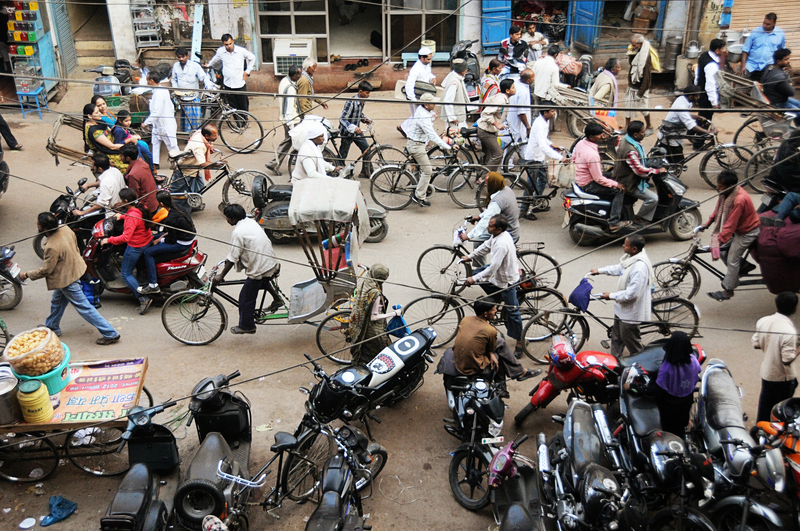
Intersections are both a blessing and a curse when it comes to transportation. Without intersections, we wouldn’t be able to navigate between our origin and destination across the network. But intersections are, by design, sources of conflict. Who gets to cross? Which ways? When? How fast? Who has to wait? Which mode(s) get preference? Which mode(s) don’t?
Planning, designing and managing intersections is a key role of transportation professionals, and the various forces at play at transportation network intersections have never been more complex than they are today. Engineers must deal with an ever-expanding array of modes of transport, including walking, scooters, bicycles, transit of all sorts, ride-sharing vehicles (soon to be increasingly autonomous), passenger vehicles, delivery vehicles and heavy good vehicles. Sidewalks, kerb space and roadways are all in use and must be considered, managed and shared.
In this increasingly complex network, transportation engineers and planners are being challenged to optimise a growing number of interrelated and sometimes competing factors – delay, safety, mode shift, transit vulnerable road users, air quality and equity, to name a few.
Now, we have yet another factor to consider – climate change. Fortunately, like many air quality issues, impacting climate change aligns with efforts to reduce delay at intersections. And increasingly, due to connected vehicles, Big Data, analytics and the like, the tools are now available to identify and reduce unnecessary delay.
Carbon reduction and signals – a new mission with new funding
In February of 2021, the US officially rejoined the Paris Agreement, an international treaty on climate change, committing to reducing greenhouse gases (GHG) by 50% below 2005 levels over the next decade. To hit these targets, the country needs to continue to reduce emissions 5% every year through 2030. Transportation accounted for 29% of greenhouse gas emissions in the US in 2021, 81% of which came from vehicle emissions. Thus, any solutions must include transportation GHG reductions.
In November 2021, President Biden signed the Infrastructure Investment and Jobs Act (IIJA), which included several provisions to target GHG reduction such as a new $6.4 billion Carbon Reduction Program (CRP), formed with the simple intent of “reducing transportation emissions”. Differing from many other new IIJA programmes that are competitive grants, CRP is a formula programme. This means that funding is distributed to each and every state department of transportation in the US annually over the five-year life of IIJA based on apportionment formula.
“Like many air quality issues, impacting climate change aligns with efforts to reduce delay at intersections”
Between fiscal years 2022 and 2026, each state will receive between $25m (District of Columbia) and $600m (Texas) in total CRP funding, with the average state receiving roughly $125m, for the express purpose of reducing transportation-related carbon emissions.
The funding must be expended within three years of the fiscal year allocated, meaning all funds must be expended by the fall of 2030. Several types of projects are explicitly eligible for CRP funding, and while one suspects much of the funding will be allocated to electrification, there are many other programmes and funding focused on electric vehicles, charging, et cetera. One area eligible – in fact, the first bullet listed under eligible projects – is “Establishing or operating a traffic monitoring, management, and control facility or program.”

Simply put, improving traffic signal performance is eligible for CRP funding, as Congress understood reducing unnecessary delay (delay at intersections is inevitable, but needless delay where no other system user benefits is not) decreases idling, which creates all sorts of byproduct emissions. And with less than 1% of the US vehicle fleet electrified, it will be many years - if not decades - before the combustion engines belch their last gasp on US highways.
How do you quantify intersection emissions?
Inrix has completed several research efforts in recent years to determine the impact of signalised intersection delay on emissions, and the potential benefits of reducing delay. Inrix has created a Green Signals Calculator to allow signal system operators and planners to calculate the benefits of improving signal performance to instantly see what kinds of green savings they can expect.
The FHWA Congestion Mitigation and Air Quality Improvement (CMAQ) Program released an Emissions Calculator Toolkit for use by agencies to estimate air quality benefits. As part of that toolkit, an intersection improvements module was created that uses the emissions rates from national level runs of the EPA Motor Vehicle Emission Simulator (Moves).
Leveraging the intersections module within the CMAQ toolkit, the Green Signals Calculator estimates the amount of fuel, CO2 equivalents, and other emissions produced at signalized intersections due to idling.
In total, a collective hour of vehicle idling generates in 0.37 gallons of fuel burned, which in turn generates the following emissions:
• Carbon Dioxide Equivalent (CO2e): 7.433346 lbs
• Carbon Monoxide (CO): 0.01366 lbs
• Nitrogen Oxide (NOx): 0.00554 lbs
• Volatile Organic Compounds (VOC): 0.003426 lbs
• Particulate Matter <2.5 μm (PM2.5): 0.000272 lbs
• Particulate Matter <10 μm (PM10): 0.000249 lbs
Early this year, we also published the Inrix US Signals Scorecard 2022 Annual Summary, which for the first time provides network-wide estimates for intersection volumes and signal performance, by assessing the individual performance of more than 242,000 intersections over several weeks in different months and seasons. This is made possible through Inrix Signal Analytics, which summarises the movements of over 10 million connected vehicles as they interact with known signalised intersections.
Key findings related to emissions include:
• Average signalised intersection daily volume: ~23,300 vehicles
• Average delay/vehicle each crossing: 18.1 seconds
• Total daily delay, average signal: 117.4 hours
A conservative assumption suggests there are 300,000 total traffic signals in the US. According to our findings, the average signal generates 117.4 hours of idling daily. If average delay is reduced by 1 second, total delay/idling would be reduced by 6.49 hours daily.
How Big Data can lower signal delay and its impacts
Every hour of delay reduced has direct impacts on emissions, not next year or a decade in the future, but today. The good news is that tools are now available for signal managers to cost-effectively monitor any or all signalised intersections so they can proactively spot temporary or permanent issues creating unnecessary delay.
Connected Vehicles, Big Data Analytics and years of foundational research, including the Pooled Fund Study on Signal Performance Measures, now enable solutions, including Inrix Signal Analytics, that sample and summarise vehicle movements and interactions with traffic signals. Agencies in more than 20 states are now using these tools in the main to spot and reduce unnecessary delay. There are multiple ways these tools are making a difference:
- Identifying broken or malfunctioning equipment, such as detectors
- Corridor progression not occurring as planned
- Signals and timeframes where current day/time signal plans don’t match actual demand
- Imbalanced performance of opposing movements, indicating opportunity for reallocating green times
- Intersections with design issues, such as persistent turn lane spillbacks
- Determining signals with variable and volatile demand that could be candidates for adaptive signal control
Real-world application, real-world results
As part of the 2022 Annual Performance Report of its Mobility Management Center (MMC), the City of Austin and Kimley-Horn documented the impact of their ongoing proactive use of Big Data to monitor the city’s 1,100 traffic signals. Weekly summaries to spot increases in stops and delays at signals trigger staff investigation to remedy issues, usually before even noticed by the public.
The MMC identified 120 distinct issues in 2022 - many of these being broken equipment or changes in traffic patterns that resulted in unnecessary delay. The MMC then adjusted signal timing to improve the “target” movements that were struggling the most and tracked the improvement using the same tools. On average, the MMC improved the target movement delay by 35% and improved the overall intersection by 23%.
“There are no societal losers in reducing unnecessary delays"
MMC staff estimated that proactive detection and improvements yielded delay reductions 30 days sooner on average than reactive approaches that typically rely on public complaints. The sum of all these changes impacted 14 million trips and saved Austin drivers more than 24,000 hours of collective delay in 2022. These improvements reduced the signal systems carbon footprint by nearly 90 tons of CO2 equivalents in 2022, tied purely to quicker identification and resolution of these issues.
Reducing unnecessary delay is a win-win-win
Transportation professionals do not just manage vehicle movements, they rather aim to optimise the performance of the network to support all users, encourage a thriving community and reduce negative impacts as much as possible. Reducing vehicle delay is not always the top priority.
That said, there are no societal losers in reducing unnecessary delays. In both the short- and long-term, vehicle operators benefit - but so do other system users with cleaner air and safer streets (and less frustration).
ABOUT THE AUTHOR:
Rick Schuman is Inrix vice president of public sector













